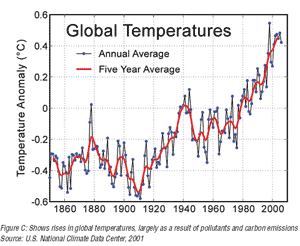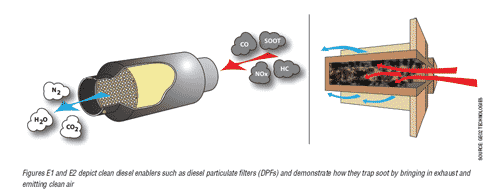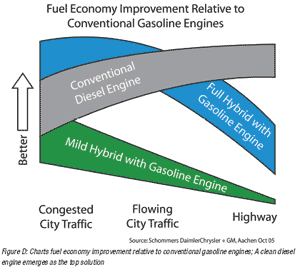Picking Up Speed
Hybrid engines and other new technologies are making rapid advances in controlling automotive emissions and improving fuel efficiency
 Nearly four decades ago, a dramatic
deterioration of air quality and
repeat occurrences of smog in
large cities such as New York and Los
Angeles led to national recognition of
the growing problem of pollution from
the automotive sector. As a result, Congress
passed the Clean Air Act of 1970 –
the first major environmental law
intended to improve air quality by reducing
emissions and pollutants from their
sources. A key aspect of this legislation
was the identification of “criteria pollutants,”
specific constituents of air pollution
such as ozone, sulfur oxides, nitrogen
oxides and carbon monoxide, which
would be monitored and controlled via
additional regulations.
Nearly four decades ago, a dramatic
deterioration of air quality and
repeat occurrences of smog in
large cities such as New York and Los
Angeles led to national recognition of
the growing problem of pollution from
the automotive sector. As a result, Congress
passed the Clean Air Act of 1970 –
the first major environmental law
intended to improve air quality by reducing
emissions and pollutants from their
sources. A key aspect of this legislation
was the identification of “criteria pollutants,”
specific constituents of air pollution
such as ozone, sulfur oxides, nitrogen
oxides and carbon monoxide, which
would be monitored and controlled via
additional regulations.
|
Additional Cost ($) |
Reduction in CO2 (%) |
Purchase payback period (years) |
| Advanced gasoline direct injection |
742 |
24 |
3 |
| Diesel |
1141 |
24 |
3 |
| Advanced Diesel Engines |
469 |
18 |
2 |
| Gasoline Hybrid |
3186 |
48 |
7 |
| Diesel Hybrid |
>3000 |
>50 |
>7 |
Emissions Reduction Progress
During the past few decades, the automotive
industry has made tremendous
advances in reducing pollutants in auto
emissions. In some cases, such as the reduction of diesel particulate emissions
in Europe, the industry voluntarily introduced
new and clean technologies, but,
in other cases, progress is largely a result
of aggressive legislation. For example,
the tailpipe emissions of hydrocarbons
from gasoline cars were reduced from
10.6 gallons per mile (g/mile) in 1971 to
0.06 g/mile by 2004. In addition, smogproducing
NOx was reduced from 3.6
g/mile to 0.05 g/mile.
Despite those reductions, the rapid
growth in car sales around the world,
especially in countries with developing
economies such as China and India, has
increased the need for a continued
decrease in automotive emissions. Additionally,
now that the link between carbon
dioxide emissions and global warming
is firmly established (See Figure C),
it has become imperative to innovate
around technologies that reduce emissions
and improve fuel economy simultaneously.
With or without pressure
from global treaties to curb greenhouse
gas emissions, e.g. the Kyoto protocol,
the automotive industry is positioned to
accept and meet these challenges.
In order to reduce tailpipe emissions
of carbon monoxide and un-burnt
hydrocarbon vapors, catalytic converters
were introduced in the United States
on all new gasoline cars in 1980.
Between 1980 and 1993, on-board
diagnostic controls and three-way catalytic
converters were also introduced.
The new solutions used finely dispersed
platinum, palladium and rhodium as
catalysts on ceramic honeycomb substrates
and simultaneously reduced
carbon monoxide, hydrocarbons and
nitrogen oxides in the tailpipes. Threeway
converters remain the norm in
gasoline vehicles, although, refinements
in electronic controls and material
chemistries have improved their performance
several-fold.
It is unfortunate that while toxic gas
emissions from gasoline engines
decreased dramatically over the past few
decades, the average fuel economy of
our cars has not improved and still lags
significantly behind competitor
economies in Europe and Asia. For
example, while the U.S. corporate average
fuel economy (CAFE) hovers around
25 miles per gallon (mpg), Europe has
crossed 40 mpg limits. Japan is already
approaching 53 mpg. Similarly, while
there are only two car models on sale in
the United States that average over 40
mpg, there are over 113 such models
available for sale in Europe. In a world
where fuel economy improvements are
linked directly to global warming and
climate change, it is a shame that the
United States has not made much
progress. The U.S. automotive industry
appears to have realized the challenge at
last and is introducing more pro-environmental
technologies. Some advanced
engines today have very low emissions
and also provide high fuel economy.
Examples include advanced gasoline,
gasoline hybrid, diesel and diesel hybrid,
plug-in hybrid and, in the future, hydrogen
fuel cell vehicles.
Fuel Alternatives on the Rise
While plug-in hybrids and fuel cell
vehicles are still some years away from
commercialization, high fuel economy
Holy Grail Technology:
Hydrogen Fuel Cells
The most significant shift in the energy
source that will propel fuel-efficient car
manufacturing will happen when
hydrogen fuel cell vehicles become
widely available. However, the industry
must overcome major technological
barriers before commercial use of fuel
cells can become reality. Despite being
a common element, pure hydrogen gas
is rare and has to be isolated, compressed,
transported and stored,
requiring a large amount of energy
from other sources such as fossil fuels.
Some experts argue that automakers
can reduce carbon dioxide emissions
by a greater degree by improving
gasoline and diesel engines – rather
than by shifting to hydrogen fuel cell
vehicles. This may be true, but innovations
in materials science, especially
the use of novel hydrogen storage
materials, could change that equation
in the future. |
alternatives are already available. Nextgeneration
gasoline vehicles (e.g. VolkswagenW
Jetta GDi), gasoline-hybrid
vehicles (e.g. Toyota Prius+, Ford Escape
SUV) and diesel vehicles (e.g. Mercedes SClass,
Honda Accord diesel) are either
already available or will be available as
early as 2008. While the industry continues
to debate which technology platform
will be most successful commercially,
the ultimate decision will be made by
the consumer. In the absence of tightening
CAFÉ standards (several bills have
been introduced in the U.S. House of
Representatives), it is hoped that people
will demand more fuel-efficient vehicles
and continue the momentum started
by more progressive states such as
California, where the state is mandating
a limit on automotive greenhouse
GHG emissions.
The California Air Resources Board
(CARB) estimates that adoption of
advanced technologies (non-hybrid) can
lead to 18-24 percent improvement in
carbon dioxide emissions from the automotive
sector. However, the economics
are quite different for each technology
platform, and this is where consumers
will make choices based on price, performance,
durability and driving experience.
Table 1 provides an estimated
comparison of cost and carbon dioxide
emission reduction for five competing
technologies.
Along with advanced gasoline direct
injection, diesels and diesel hybrids
stand out as promising choices for
meeting our near-term mobility needs.
During the past decade, diesel engines
have made dramatic improvements in
performance, acceleration, fuel efficiency,
emissions and noise. Even companies
that first introduced gasoline electric
hybrids now plan to introduce “clean
diesels” in markets around the world.
For example, Honda has announced
plans to introduce diesel cars in the
United States that will offer more than
62 mpg. Given the superior performance
of clean diesel vehicles coupled with
lower taxes on diesel fuel, more than 50
percent of all new cars sold in Europe
are diesel.
 Modern-day clean diesels utilize progressive
emission control systems that
complement advances made in combustion
processes, fuel injectors and electronic
controls. The introduction of
advanced, high-porosity ceramic diesel
particulate filters (DPFs – see Figures E1
and E2) and novel catalyst systems has
made this task not only possible but also
affordable. Also, the quest for advancing
highly fuel-efficient clean diesels has
prompted rapid and breakthrough innovations
in materials and ceramic sciences,
catalyst chemistry and electronic
systems integration. Innovative small
firms and established auto companies
are working hard to make clean diesel
and diesel-electric hybrids an economically
viable reality in the near term. The
task to achieve greater than 100 mpg
fuel economy is clear and doable in the
near future.
Modern-day clean diesels utilize progressive
emission control systems that
complement advances made in combustion
processes, fuel injectors and electronic
controls. The introduction of
advanced, high-porosity ceramic diesel
particulate filters (DPFs – see Figures E1
and E2) and novel catalyst systems has
made this task not only possible but also
affordable. Also, the quest for advancing
highly fuel-efficient clean diesels has
prompted rapid and breakthrough innovations
in materials and ceramic sciences,
catalyst chemistry and electronic
systems integration. Innovative small
firms and established auto companies
are working hard to make clean diesel
and diesel-electric hybrids an economically
viable reality in the near term. The
task to achieve greater than 100 mpg
fuel economy is clear and doable in the
near future.
Automotive Emissions’
Impacts
Internal combustion engines used in
both on-road and off-road applications,
including cars, trucks, boats
and construction equipment, are significant
contributors to air pollution.
These engines emit carbon monoxide,
volatile organic gases, nitrogen
oxides, soot and carbon dioxide, and
lead indirectly to the formation of toxins
such as ozone in the atmosphere.
Epidemiological studies conducted
across the country have now identified
direct links between exposure to these
toxins and adverse health effects such
as asthma and bronchitis, as well as
cardiovascular, pulmonary and lung
diseases. In addition, gaseous and
particulate toxic pollutants in breathable
air cause nasal irritation, asthmatic
episodes and long-term tissue
damage. Inhalation of fine particulate
matter (soot) can also lead to
bronchial problems and scar tissue
formation deep inside the lungs. Finally,
greenhouse gas emissions from the
automotive sector influence global
phenomena such as abrupt climate
change, reduction in crop harvests
and increased occurrence of acid rain.
SOURCE: UNION OF CONCERNED SCIENTISTS |
More Fuel Choices on the Horizon
While clean-diesel vehicles are the
best-in-class choice to solve the automotive
emissions problem of today,
there is certainly a need to develop technologies that will lead to further
advancements over the longer term.
Recently, some innovators have
focused on the use of bio-fuels — particularly
corn-based ethanol fuels.
Ethanol-fueled vehicles have lower
toxic emissions per unit distance traveled
but provide lower fuel economy
(mpg) than current gasoline engine
vehicles. While there is a case to be
made for reducing energy dependence
on imported oil, the positive environmental
impact and the negative
impact on food prices due to widespread
use of ethanol as fuel is still
in question.
Despite the viable solutions on the
horizon – diesel hybrids, fuel cell vehicles,
etc. – and the tremendous innovation
already achieved, automakers
must challenge themselves to innovate
at the next level. Current fuel-efficiency
standards and increases in global
warming underscore a need for newer
technologies that not only reduce
emissions from the tailpipe but also
convince consumers to make a conscious
shift toward adopting more fuelefficient
automobiles. Continued innovation
and an overall reduction of
CO2 emissions from the transportation
sector are not only the most responsible
courses of action, but also opportunities
for the automakers to reinvent
themselves as the vanguards of
clean transportation and a cleaner
environment.
This article originally appeared in the 11/01/2007 issue of Environmental Protection.
About the Author
Dr. Bilal Zuberi is a co-founder and the vice president of product development for GEO2 Technologies, a Boston-based materials science technology development firm with a special focus on emissions reduction from internal combustion engines. Dr. Zuberi holds a PhD in physical chemistry from the Massachusetts Institute of Technology (MIT), where he worked on microphysics of atmospheric emissions such as soot particles, heterogeneous atmospheric chemistry, and urban air pollution, especially pollution in mega-cities, under Professor. Mario J. Molina (Chemistry Nobel Laureate, 1995). He is an author of several peer-reviewed publications and U.S. patents in the area of atmospheric chemistry, materials science, and automotive emissions reduction. Dr. Zuberi can be reached by phone at (781) 721-6306.